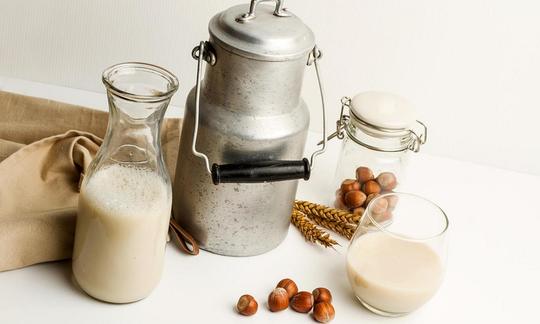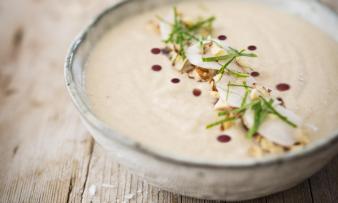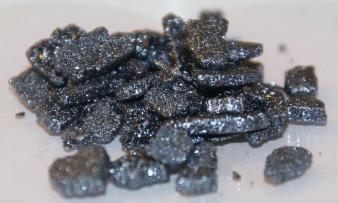Table of contents
Hazelnut milk , commercially available as hazelnut drink or hazelnut beverage , is made from hazelnuts ( Corylus spp.) and water . Like other plant milks It is used in vegan cuisine as an alternative to cow's milk. Commercial hazelnut milk is usually not raw , but is often available in organic quality .
Use in the kitchen
Hazelnut milk (hazelnut drink, hazelnut beverage) is a lactose-free, vegan plant milk that is mainly made from hazelnuts and water. Commercially available drinks are often no longer considered raw food because they are heated during production to make them shelf-stable and germ-free. If you want raw hazelnut milk, it is best to make it yourself (see the chapter "Your own preparation"). The taste of the slightly brownish nut milk is intensely nutty. Store-bought hazelnut milk often tastes slightly sweet due to added sugar or other sweeteners.
The possible uses of a plant-based drink can be compared to those of cow's milk, which is why nut milk (nut drink) is suitable as a vegan milk substitute.
What dishes are there with hazelnut milk? You can enjoy the vegan drink cold or warm (e.g. as drinking chocolate with a little cinnamon , as a smoothie or frappé or as an ingredient in coffee), but you can also use it for cooking or baking sweet or savory dishes. Hazelnut milk is suitable for muesli, porridge, semolina pudding and vegan rice pudding as well as for making pancakes, waffles (e.g. with berries, oranges or apple sauce ), cakes and hazelnut spread. Fine soups or creamy sauces - such as for soy strips with vegetables, potato gratin or vegetable casserole - can also be cooked with hazelnut milk. We have a raw vegan soup variation with hazelnut milk: Raw Jerusalem artichoke and parsnip cream soup .
Homemade preparation
Can you make hazelnut drink yourself? Hazelnut milk is easy to make yourself. Below you will find a simple recipe.
Ingredients: 150 g hazelnuts (raw, organic), 1 L water , 1 tbsp maple syrup (optional), 1 pinch of salt , some cinnamon (optional).
Preparation: Soak the hazelnuts in plenty of water for a few hours (at least four - even better overnight). Pour away the soaking water and rinse the nuts briefly in a sieve. Put the hazelnuts, water, maple syrup (optional) and salt in a blender and mix until you have a homogeneous mass. If you like, you can season with a little cinnamon. Put the mass in a nut milk bag or a kitchen towel that is in a sieve over a bowl and filter. Pour the resulting hazelnut milk into a clean, airtight bottle and store in the refrigerator. Excess hazelnut mass (pomace) can be used for other purposes: e.g. by drying it and using it as hazelnut flour for baked goods - or as a rich addition to smoothies and muesli.
Vegan recipe for kohlrabi and hazelnut soup
Ingredients (for 4 people): 600 g kohlrabi , 1 onion , 1 tbsp rapeseed oil , 100 ml white wine or water, 100 ml vegetable stock , 1 pinch of nutmeg (ground) , 100 g hazelnuts (organic), 500 ml hazelnut milk (organic), 1 clove of garlic , some salt andpepper .
Preparation: Peel the kohlrabi and cut into cubes. Peel the onion and chop finely. Heat the rapeseed oil in a saucepan, sauté the onion in it and deglaze with white wine (water). Add the kohlrabi and sauté briefly. Add the vegetable stock and bring to the boil. Sprinkle nutmeg into the soup and simmer for approx. 20-30 minutes until the kohlrabi is soft. Roughly chop the hazelnuts. Pour the hazelnut milk into the saucepan and let it bubble. Add the peeled garlic clove and puree everything with a hand blender to form a creamy soup. Season the vegan kohlrabi-hazelnut soup with a little salt and pepper. Garnish with the chopped hazelnuts and optionally with a little parsley .
Vegan recipe for golden hazelnut rice pudding with peach
Ingredients (for 1-2 people): 130 g short grain rice , 250 ml hazelnut milk (organic), 250 ml water , 1 tbsp maple syrup , 1 tsp turmeric (ground ), 1 tsp ginger (ground) , ½ tsp cinnamon , 1 pinch of salt , somevanilla powder or vanilla extract , 1 peach .
Preparation: Mix the hazelnut milk, water and maple syrup and add the rice. Bring the rice pudding to the boil briefly, stirring constantly, then reduce the heat. Season with turmeric, ginger, cinnamon, salt and vanilla and mix everything well. Cook while stirring occasionally. Meanwhile, rinse the peach, remove the pit and cut into slices. As soon as the rice has absorbed the liquid, the vegan rice pudding should be ready. Serve in a bowl and garnish with the peach slices.
Vegan recipes with hazelnut milk can be found under the note: " Recipes that have the most of this ingredient ".
| Not only vegans or vegetarians should read this: Vegans often eat unhealthily. Avoidable nutritional mistakes . |
Purchasing - Storage
In the EU, hazelnut milk is sold under the name hazelnut drink or hazelnut beverage, as plant-based alternatives to cow's milk are not allowed to be labelled as milk. 7
Pure hazelnut drinks can be found in well-stocked branches of some supermarkets (e.g. Spar , Lidl , Rewe , Edeka ). Other supermarkets (e.g. Coop , Migros ) only offer hazelnut drinks mixed with oat milk , almond milk or rice milk , and yet other supermarkets (e.g. Denner , Volg , Aldi , Hofer , Billa ) rarely or never have them on offer. Hazelnut milk is most likely available in organic supermarkets (e.g. Alnatura , Denn's Biomarkt ) and health food stores.
As mentioned, many of the hazelnut drinks available are sweetened and enriched with vitamins, minerals and other additives. In addition, most are UHT treated (ultra-high temperature), meaning they have been sterilized and preserved at temperatures above 135 °C. These hazelnut drinks are therefore not considered raw food.
Is there hazelnut milk without sugar? If you want a natural hazelnut milk, unsweetened and without additives, we recommend that you prepare your own plant-based drink (see the chapter "Your own preparation").
The availability of hazelnut drinks varies depending on the size of the store, catchment area, etc. If you are interested, click on our recorded food prices for the DA-CH countries (above under the ingredient image). There you will find current prices from various supermarkets and their price development.
Storage tips
Since many of the hazelnut drinks you buy are ultra-high temperature (UHT), they will last for several months unopened at room temperature. Opened hazelnut milk should be stored in the refrigerator and ideally used within a week. However, it can still be edible after two weeks. Trust your eyes and your sense of smell and taste. If the milk smells rancid or musty, tastes sour or has a greasy consistency, you should not use it. Homemade hazelnut milk usually lasts for 3-4 days.
Note: Always shake well before use to mix the ingredients and avoid lumps.
Ingredients - nutritional values - calories
The ingredients of hazelnut milk depend very much on the product in question. The ingredients for this ingredient are a composition that can be found in many commercially available hazelnut drinks. These usually have a hazelnut content of < 5% and added emulsifiers and stabilizers. They are usually sweetened and enriched with vitamins and minerals (for example with vitamin B 12 or calcium ). This is either done to compensate for the losses caused by heating or to make the composition more attractive to customers.
Hazelnut milk consists largely of water, namely around 93.7%. It contains only 28 kcal per 100 g. The fat content is low at 1.6 g per 100 g, as is the protein content at 0.4 g/100 g. Carbohydrates are contained at around 3.4 g per 100 g. 8
Commercial hazelnut milk contains 120 mg of calcium per 100 g (15% of the daily requirement), which is significantly more than other plant milks such as almond milk (46 mg/100g), soy milk (25 mg/100g), oat milk (15 mg/100g) and rice milk (1.8 mg/100g). Unpeeled sesame seeds are naturally very rich in calcium (975 mg/100g). 1
100 g of hazelnut milk also contains 1.8 mg of vitamin E (15% of the daily requirement). Almond milk contains more vitamin E (4.1 mg/100g), while oat milk (0.5 mg/100g), rice milk (0.46 mg/100g) and soy milk (0.11 mg/100g) contain slightly less. Hazelnut oil contains 47 mg/100g, which is about 26 times as much vitamin E - but you have to remember to only use small amounts at a time. 1
The content ofriboflavin (vitamin B 2 ) is 0.2 mg/100g (14% of the daily requirement). Almond milk contains a similar amount (0.18 mg/100g). Almond butter , for example, contains significantly more at 0.94 mg/100g. 1
The complete ingredients of hazelnut milk, the coverage of the daily requirement and comparison values with other ingredients can be found in our nutrient tables. In the article Nutrients explained you will get a detailed insight into the topic.
Effects on health
Is hazelnut milk healthy? Hazelnut milk is particularly recommended for people with lactose intolerance, milk protein allergies or soy allergies. For vegans and ovo-vegetarians, it is a popular substitute for cow's milk, along with other plant-based drinks.
Studies have shown a connection between milk consumption and acne. The higher the milk consumption, the higher the prevalence of acne. 2 Avoiding cow's milk and replacing it with plant-based drinks can therefore improve the appearance of the skin. You can find more reasons why you should avoid cow's milk in the book review "Milk is better not" .
Hazelnut milk contains bioactive compounds that exhibit antioxidant activities. A 2015 study examined this antioxidant activity in fermented hazelnut milk and the results suggest that it may have health-promoting and probiotic effects. 3
Studies on the health aspects of hazelnuts and the ratio of omega-3 and omega-6 fatty acids can be found in the associated article.
Dangers - Intolerances - Side effects
Anyone who has allergic reactions to hazelnuts should avoid hazelnut milk.
Is almond milk better tolerated by people with hazelnut allergies? Many people suffer from allergies to several nuts or tree nuts. 6 In this case, caution is also advised when consuming almond milk (almond drink) .
Ecological footprint - animal welfare
Plant-based milk alternatives have a smaller ecological footprint than cow's milk (in terms of CO2 emissions), require less land and water, and are more animal-friendly. 9 However, there are still big differences between plant-based drinks in terms of sustainability. Hazelnut bushes have a higher water requirement than oats or soy, for example, and are sensitive to drought. Accordingly, in some areas, such as Italy, hazel bushes are artificially irrigated. 10 In total, 5260 litres of water are needed to produce 1 kg of hazelnuts, 2145 litres for the same amount of soybeans, and 1788 litres for oats. 11 Of all plant-based milk alternatives, oat milk has the smallest ecological footprint if it is grown and processed regionally.
Hazelnuts are native to Europe. When shopping, it is best to look for hazelnut milk made from European hazelnuts (for example from Belgium and Spain). Organic products also guarantee that no synthetic fertilizers or pesticides are used; you can read more about the advantages of organic hazelnut cultivation under the ingredient hazelnuts, raw (organic?) . Under the ingredient rice milk, we provide information about the possible enrichment of plant drinks with calcium using algae lime.
Animal welfare - species protection
Hazelnut bushes do not depend on insects such as honey bees for pollination, but on the wind. 12 This is much more animal-friendly than almond trees, for which large bee colonies travel around California (see the ingredient almond milk ).
Worldwide occurrence - cultivation
Hazelnut milk drinks are mainly available in western countries. They are produced in Europe, including Belgium and Spain. 4
Further information
Although hazelnut milk is a promising plant-based milk alternative, it is not consumed as frequently as soy milk or almond milk due to its rare availability and slightly higher price. 5
Other plant-based drinks include oat milk and rice milk . Plant-based drinks can also be made from peas (yellow split peas), coconut meat , hemp seeds , millet and lupins.
Alternative names
for hazelnut milk can be found in stores under the term hazelnut drink or hazelnut beverage. Incorrect spellings (e.g. hazelnut milk, hazelnut mulch, hazelnut milk, hazelnut milk) creep in.
In English it is called hazelnut milk or hazelnut drink.
Bibliography - 12 Sources
| 1. | USDA United States Department of Agriculture. |
| 2. | Spencer EH, Ferdowsian HR, Barnard ND. Diet and acne: a review of the evidence. Int J Dermatol. 2009;48(4):339–47. |
| 3. | Maleki N, Khodaiyan F, Mousavi SM. Antioxidant activity of fermented Hazelnut milk. Food Sci Biotechnol. 2015;24(1):107–15. |
| 4. | Aysu Ş, Akıl F, Çevik E et al. Development of homemade hazelnut milk-based beverage. J Culin. Sci. Technol. 2020;0(0):1–9. |
| 5. | Gul O, Atalar I, Mortas M et al. Application of TOPSIS methodology to determine optimum hazelnut cake concentration and high pressure homogenization condition for hazelnut milk production based on physicochemical, structural and sensory properties. Food Measure. 2018;12(4):2404–15. |
| 6. | The University of Manchester. The InformAll Database. Allergy information for: Hazelnut (Corylus avellana). 2006. |
| 7. | Verordnung (EU) Nr. 1308/2013 des Europäischen Parlaments und des Rates vom 17. Dezember 2013. TEIL III: Milch und Milcherzeugnisse. 20.12.2013. |
| 8. | Diet-health.info Nährstofftabellen. |
| 9. | Geburt K, Albrecht EH, Pointke M, Pawelzik E, Gerken M, Traulsen I. A Comparative Analysis of Plant-Based Milk Alternatives Part 2: Environmental Impacts. Sustainability 14. 2022. |
| 10. | Nera E, Paas W, Reidsma P, Paolini G, Antonioli F, Severini S. Assessing the Resilience and Sustainability of a Hazelnut Farming System in Central Italy with a Participatory Approach. Sustainability. 2020; 12(1) 343. |
| 11. | Mekonnen MM, Hoekstra AY. The green, blue and grey water footprint of crops and derived crop products. Hydrol. Earth Syst. Sci. 2011; 15:1577-1600. |
| 12. | Germain E. The Reproduction of Hazelnut (Corylus avellana L.): A review. ISHS Acta Horticulturae. 1994; 351. |













Comments